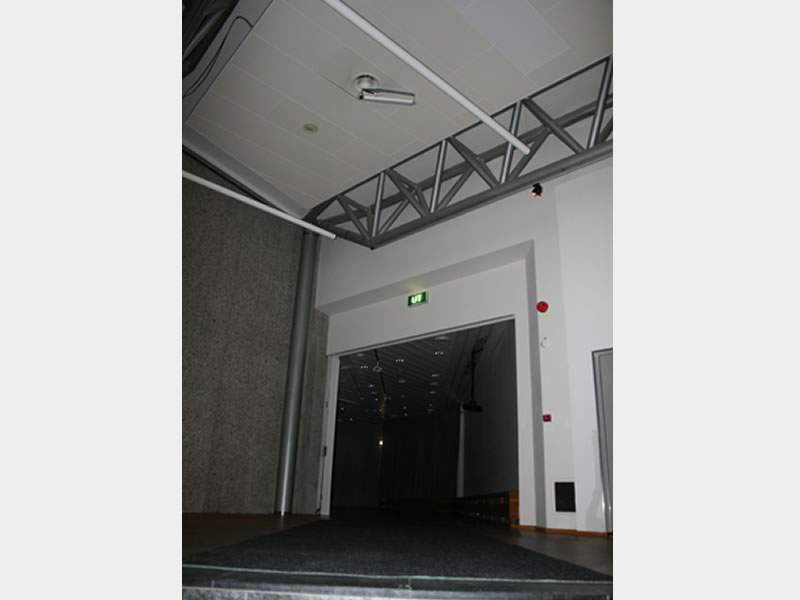selected work
objects/installations
Kinetic sound sculpture
Dimensions variable

As a musical form, whistling is often associated with a cheerful demeanor, or used to make casual, the passage of time. The body becomes an instrument as turbulent air is forced inwards and outwards through the resonant chamber of the mouth, forming and moderating the sound by subtle movements of the lips, tongue and teeth. These coded tones can be as concrete as a syntactic language or as evasive as a memory. In popular usage, a combination of as few as two notes are commonly used to express emotion, desire, beckoning, and warning with at times, and purposeful ambiguity that has associated whistling with mystery and superstition.
Swing Low is an audio sculpture work derived from the old spiritual, “Swing Low, Sweet Chariot”. Through a dynamic sound focusing system, the sound ‘swings’ back and forth across the room like a pendulum - or lynch rope. Bearing a reference to lynching - the hung body, hanging from a tree, and the subject’s voice - the disembodied and elusive voices present in the audio, the tones take on a phantom-like presence as they physically swing through the actual body of the listener. The voices momentarily take possession of, and capture the body of the listener as subject in a historical narrative that maintains vast global relevance with respect to the continued and growing oppression of cultures and individuals world-wide. While present within the ‘zone’ of the work, the body of the listener becomes an object of the sculpture itself.
The audio content is built from recordings of a variety of people individually whistling the first two notes of “Swing Low, Sweet Chariot”, the notes that represent the words “swing low”. Each note was sustained for the duration of an entire exhale sometimes resulting in a slight strain in the tone followed by a deep audible inhale. These recordings are played through the moving sound focusing speaker, at times individually, at other times as a call and response. The tones slip in and out of harmony and dissonance while simultaneously moving in and away from the auditory range of the listener. The experience is both hauntingly beautiful and abrasively disturbing.
“Swing Low, Sweet Chariot” is a song born from a tragic history that has had, and continues to have, an astounding number of vocal recordings made from little-know groups and individuals, to world renowned pop singers all over the world. Ironically, “Swing Low” also became the theme song for England’s Rugby World Cup tournament. Though several persons are accredited with first committing the song to paper, it is generally acknowledged that it was created by a former slave whose name is unknown. The spread of this voice of anonymity to the voice of popular culture icons, further enriches the ironic conceptual premise of the work.

As a musical form, whistling is often associated with a cheerful demeanor, or used to make casual, the passage of time. The body becomes an instrument as turbulent air is forced inwards and outwards through the resonant chamber of the mouth, forming and moderating the sound by subtle movements of the lips, tongue and teeth. These coded tones can be as concrete as a syntactic language or as evasive as a memory. In popular usage, a combination of as few as two notes are commonly used to express emotion, desire, beckoning, and warning with at times, and purposeful ambiguity that has associated whistling with mystery and superstition.
Swing Low is an audio sculpture work derived from the old spiritual, “Swing Low, Sweet Chariot”. Through a dynamic sound focusing system, the sound ‘swings’ back and forth across the room like a pendulum - or lynch rope. Bearing a reference to lynching - the hung body, hanging from a tree, and the subject’s voice - the disembodied and elusive voices present in the audio, the tones take on a phantom-like presence as they physically swing through the actual body of the listener. The voices momentarily take possession of, and capture the body of the listener as subject in a historical narrative that maintains vast global relevance with respect to the continued and growing oppression of cultures and individuals world-wide. While present within the ‘zone’ of the work, the body of the listener becomes an object of the sculpture itself.
The audio content is built from recordings of a variety of people individually whistling the first two notes of “Swing Low, Sweet Chariot”, the notes that represent the words “swing low”. Each note was sustained for the duration of an entire exhale sometimes resulting in a slight strain in the tone followed by a deep audible inhale. These recordings are played through the moving sound focusing speaker, at times individually, at other times as a call and response. The tones slip in and out of harmony and dissonance while simultaneously moving in and away from the auditory range of the listener. The experience is both hauntingly beautiful and abrasively disturbing.
“Swing Low, Sweet Chariot” is a song born from a tragic history that has had, and continues to have, an astounding number of vocal recordings made from little-know groups and individuals, to world renowned pop singers all over the world. Ironically, “Swing Low” also became the theme song for England’s Rugby World Cup tournament. Though several persons are accredited with first committing the song to paper, it is generally acknowledged that it was created by a former slave whose name is unknown. The spread of this voice of anonymity to the voice of popular culture icons, further enriches the ironic conceptual premise of the work.
